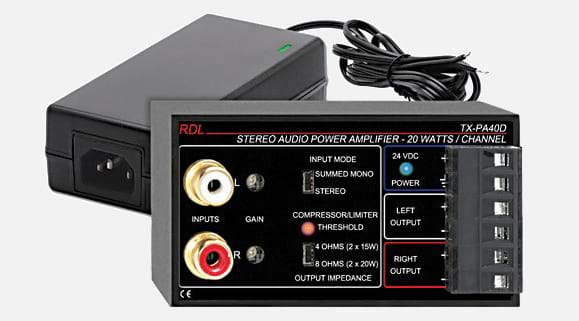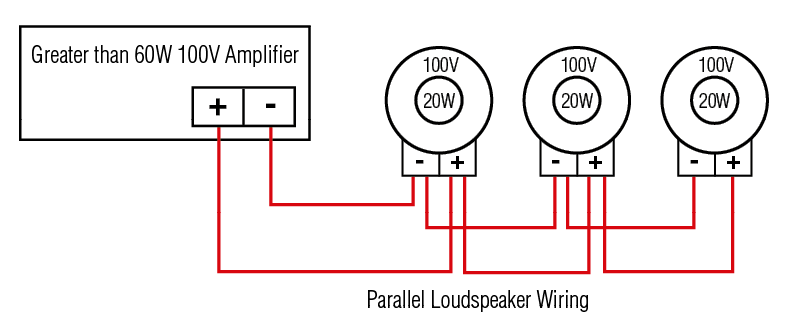
Author: Stephen Gallagher
No matter how big or small, whenever you are designing a public address, background music, zoning, paging or live performance audio system, you will need to make some decisions relating to the type of amplification, loudspeakers and therefore wiring convention to use.
Modern techniques now exist for distributing audio over data networks with the likes of Dante. These network distribution systems are particularly useful when creating more complex systems over large areas, where there is a need for centralised system control and audio routing. Unless your hardware (amps, speakers, mics etc) have Dante built-in, you'll need some sort of interface product to get the audio onto, and off of the data network.
Specialist audio manufacturers such as RDL provide Dante and Format-A network audio interfaces. In essence these are ‘clever black boxes’ which can be used as a bridge between the audio system and data network. In short, they get your audio onto a data network and provide the endpoints wherever on the network you may wish to retrieve it for local amplification.
No matter whether you intend to use a traditional or more modern networked approach to distributing your audio signal there are really only two types of amplification and loudspeaker system to consider. It’s all to do with physics, and the choice boils down to Low or High Impedance hardware. Your decision should be determined by the specifics of your application.
It helps to first understand that impedance is the resistance to a flow of alternating current. It is measured in units called Ohms and displayed with the symbol Ω. Low impedance equipment is typically rated between 2 - 16 Ω.

Low Impedance systems are perhaps best suited to foreground applications and live performances, where high-powered loudspeakers are required. Situations requiring short cable runs and where a single stereo pair of loudspeakers is required. Classrooms and meeting room installations are good examples, where an un-balanced line-level audio signal is taken from a TV, laptop or media player and passed via a low impedance amplifier such as the RDL TX-PA40D to drive a single pair of loudspeakers.
Each output channel on a low impedance amplifier has two terminals, a positive and negative. These outputs are typically via Euroblock connectors, but can also be spring clips or connectors such as the Neutrik Speakon. Each output channel is typically intended to power a single loudspeaker, although it may be possible to connect multiple low impedance loudspeakers, wired in parallel, provided the total loading at the amp does not exceed the manufacturer’s specifications.
 Typical low impedance wiring of a single stereo pair
Typical low impedance wiring of a single stereo pair
 Low impedance system wired in parallel to increase the qty of loudspeakers while matching the impedance load to the amplifier
Low impedance system wired in parallel to increase the qty of loudspeakers while matching the impedance load to the amplifier
High impedance systems include 25V, 70V or 100V options. 100V is the common derivative used throughout the UK and Europe. High impedance (or 100V) systems are regarded as being relatively simplistic. They can also be called 100V Line or Constant Voltage systems. The names are entirely interchangeable.
100V loudspeaker systems are better suited to public address and background music (BGM) applications or large installations requiring longer cable runs with multiple loudspeakers. Application examples would include supermarkets, office buildings, restaurants, airports and leisure complexes combining music with paging announcements.
Although some high-powered performance models do exist, such as in the CS-C Series Loudspeakers from Cloud Electronics, 100V high-impedance speakers generally offer lower output wattage than low impedance models.
Wiring a high impedance 100V line loudspeaker system couldn’t be easier. 100V amplifiers and mixer-amplifiers will usually offer a single mono output, from which a single line of 100V loudspeakers is wired in parallel.
Loading calculations are simple. Each 100V loudspeaker incorporates a step-down 100 volt line transformer with user configurable ‘power taps’. These power tap settings are used to effectively limit or cap the maximum wattage at each loudspeaker to the selected tap value. It is possible to mix and match different tap values on a single line of loudspeakers to best match the environment they are installed. This makes 100V line systems incredibly versatile.
Transformer power-tap values vary from product to product and will drive the loudspeaker in a range according to the manufacturer’s specification. The higher the tap, the louder the output.
 Typical 100V System wired in parallel
Typical 100V System wired in parallel
When designing a 100V system it is important to ensure that the combined output wattage, as set by the loudspeaker power taps, does not exceed the capacity of your amplifier. In fact, it is advisable to leave some headroom so as not to overload the system!
It is possible to build more complex systems to include different types of loudspeaker; ceiling, wall and IP rated for example, with differing output setting (power taps) to suit the environment. This could be combined with mixer amplifiers making it possible to route a number of different audio sources to several zones and provide for localised input selection and volume control.
A restaurant might be a good example of this, where a manager wants one audio track playing at low level in reception but something else in the dining room. Maybe they have a bar too, where they’d like the music a little louder.
Although it may be possible to get an audio signal from one end of a piece of mains cable to the other, it is recommended that you use high-quality cable which has been designed specifically for loudspeaker installations. This will reduce the risk of system failure and costly service calls. Low grade cabling, especially when used in high-impedance 100V systems can negatively impact the audio fidelity.
 Canford offers its HLS-LFH which is specifically intended for use in public buildings, factories, offices, shops etc., the insulation and jacket materials are LFH compounds (low fire hazard), rather than PVC. Cables using these materials are increasingly often now mandatory in public building installations. Under combustion circumstances, LFH cables have a significantly reduced smoke emission, and the gaseous products contain no toxic halogens. To help identify the PA system cable from the many others usually now found in building ductways, it is distinctively coloured blue, and is printed “loudspeaker cable” at regular intervals.
Canford offers its HLS-LFH which is specifically intended for use in public buildings, factories, offices, shops etc., the insulation and jacket materials are LFH compounds (low fire hazard), rather than PVC. Cables using these materials are increasingly often now mandatory in public building installations. Under combustion circumstances, LFH cables have a significantly reduced smoke emission, and the gaseous products contain no toxic halogens. To help identify the PA system cable from the many others usually now found in building ductways, it is distinctively coloured blue, and is printed “loudspeaker cable” at regular intervals.
For more great content, download a copy of Source Material:
